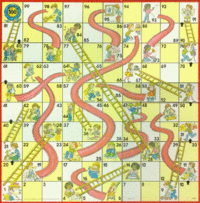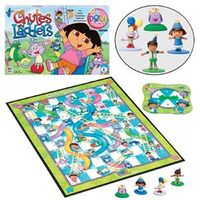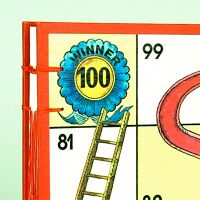Chutes and Ladders
Chutes and Ladders is a metaphor for life.[1] As such, it is arguably the most philosophical of all children's board games, alongside Checkers (which serves as both an example and microcosm of war and conflict) and Duck-Duck-Goose (which—though not a board game in the strict sense of the term—exemplifies the concept of “survival of the fittest” as well as the “hunter-hunted/dominance-submission” trope). Because of its underlying philosophical nature, Chutes and Ladders has by far received the most academic attention of any board game,[2] with a great deal of controversy surrounding the various interpretations of the game’s titular “chutes” and “ladders.”
The Game
The game of Chutes and Ladders itself consists of a square board made up of 100 squares (ten squares by ten squares).[3] To play, players roll a single die and advance their token the rolled number of spaces, with the arrival at the end of the board—the Hundredth Square—being the ultimate goal.
At its most basic level, Chutes and Ladders is fairly uncomplicated. As such, academic interpretation is in near-total agreement as to the game’s larger, symbolic meaning: Chutes and Ladders is a metaphor for life. Just as Monopoly is clearly an ironic critique of the pre-War entrepreneurial capitalist American zeitgeist and Risk is a biting satire of the Great Powers’ oversimplification of modern geopolitics, Chutes and Ladders is clearly a metaphor of life itself by virtue of the fact that both the game and life have a definitive beginning and end with an inevitable (if somewhat indirect) progression from one to the other. However, both the game itself and academic interpretation thereof is complicated by the inclusion of “ladders”—certain squares that advance a player forward a certain number of squares—and “chutes”—certain squares that send a player back a certain number of squares. It is these “chutes” and “ladders” and their ultimate, underlying purpose that the vast amount of academic study of the game is largely devoted to.
Interpretations of the Game
Though there are at least a dozen distinct interpretations of Chutes and Ladders supported by academic scholarship[4] two specific and very polarized schools of thought have risen to prominence: the “morality” interpretation, which holds that the game’s “chutes” and “ladders” are a visual and physical representation of good and bad moral actions and their karmic consequences, and the “emotions” interpretation—championed by prominent Board Game Scholar Alistair Johnston—which holds that the chance element of the game is inconsistent with the fundamental “choice” element present in morality questions, and instead claims that the “chutes” and “ladders” are representative of an individual’s emotional state of mind.
The “Morality” Interpretation
The older and more established school of thought on the “chutes” and “ladders” in Chutes and Ladders holds that “ups” and “downs” of the game represent moral choices and their consequence: good deeds being a “ladder” and bad deeds being a “chute.” Most pre-Johnston Board Game Scholars adhere to this interpretation even today, despite the explosion[5] of recent research to the contrary. The most commonly-cited evidence supporting the positions of the pre-Johnston camp are the illustrations that were featured on the game’s early editions, which indeed depicted good and bad deeds and their consequences.
The “Emotion” Interpretation
In 1997, controversial Board Game Scholar Alistair Johnston—to that point best known for his work regarding the “Free Parking” question in Monopoly—published A Modern Interpretation of Chutes and Ladders, in which he not only dismissed virtually all the efforts of prior scholarship in his field (he notoriously called the conventional, moral-centric interpretation “an outmoded board game interpretation championed by outmoded board game men”), but submitted a completely new, radical interpretation of the game.
In A Modern Interpretation of Chutes and Ladders, Johnston postulated that if Chutes and Ladders were a game that centered on morality, it would have to be based around choice. However, Chutes and Ladders—with its die-rolling—is based around chance. Given, then, the incongruous nature of morals and chance (with the element of chance being absolute in gameplay), Johnston concluded that the moral-centric interpretation of Chute and Ladders was at fault. Johnston submitted that rather being a game about “morality,” the highs and lows of Chutes and Ladders represented various emotional highs and lows, as an individual’s emotions are more susceptible to whim and random chance than their moral decisions.
An integral part of Johnston’s thesis was based upon the scholar’s own hands-on Chutes and Ladders playing experience, an excerpt of which[6] is presented below:
| “ | I sat down with my four-year-old daughter on the evening of August 22, 1996 for yet another game of Chutes and Ladders. Like always, I painstakingly recorded her emotions as she played the game, as I believe that not only do the various ‘chutes’ and ‘ladders’ analog emotion, but that they cause said emotions during gameplay as well. At first my daughter was reluctant, and claimed that I only wanted to play with her because of my ‘poopy book.’ However, I eventually convinced her otherwise. Consistent with my thesis, she was overjoyed when a ladder took her from Square 24 to Square 57, and then instantly disappointed when a chute took her from Square 61 back to Square 29. She was then instantly annoyed, and once more claimed that I was only playing with her because of my book, which is inconsistent with my thesis. In all, I believe further observation is required. | ” |
Other Interpretations
Though the prominence of the respective “morality” and “emotion” camps cannot be denied, there are other notable schools of thought on the game of Chutes and Ladders as well. In 1978, a team of graduate students from MIT recorded over six thousand games of Chutes and Ladders, plotted individual player position along a time axis, and tried to correlate the resulting graphs with both North American and Asian stock market performance. Though nothing conclusive was found, the effort is no less noteworthy. In 1986, a group of paranormal enthusiasts attempted to correlate grid locations of the game’s chutes and ladders with spots of paranormal activity in the greater London area by superimposing the grid over an appropriately-scaled map. Though the effort received considerable media attention[7], nothing conclusive was found. In 1989, literary professor Albert Brown—known for his groundbreaking work in measuring the cursive slant in all of Emily Dickinson's manuscripts with a protractor—noted that the game was both competitive but entirely based around chance, and that it therefore represented a Nihilist interpretation of life. Finally, in 2004, an undergraduate student from Princeton wrote an editorial in the school’s newspaper brazenly declaring that Chutes and Ladders was “just a board game” and that the academic community was “a bunch of pretentious idiots” that were “wasting their time” looking for “things that aren’t there.” The student’s proclamation was rightfully ignored by the academic community.[8]
Footnotes
- ↑ Though game creator, literary genius and polymath Milton Bradley, never discussed Chutes and Ladders or any of his other works outright, this remains the general academic consensus.
- ↑ A distinction that is often misattributed to Monopoly. Though Monopoly’s “Free Parking Question”—that is, whether or not one gets any sort of “jackpot” by landing on the Free Parking space—is the most discussed single question in board game academia, Monopoly is not the most discussed game.
- ↑ There also exist both 12x12 and 8x8 sized boards, though these are generally considered either poor facsimiles made by Bradley imitators or hackneyed, incomplete versions of the original game, the later being the result of heavy-handed editing by profit-hungry publishers.
- ↑ And 62 that aren’t
- ↑ In academic metaphorical terms, an “explosion” refers to 12-18 articles/books on the subject in question published within a three-year period. It is more than a “plethora,” which is just 8-12 articles/books, but less than a “library,” which is 18-36 published works.
- ↑ Johnston would play with his daughter on 438 occasions while writing A Modern Interpretation of Chutes and Ladders, though he only includes transcripts for 326 of them.
- ↑ Particularly from basic-cable niche-market channels like The History Channel and SciFi.
- ↑ As are most pleas from the sane.
See Also
| Featured version: 24 August 2009 | |
| This article has been featured on the main page. — You can vote for or nominate your favourite articles at Uncyclopedia:VFH. | |




